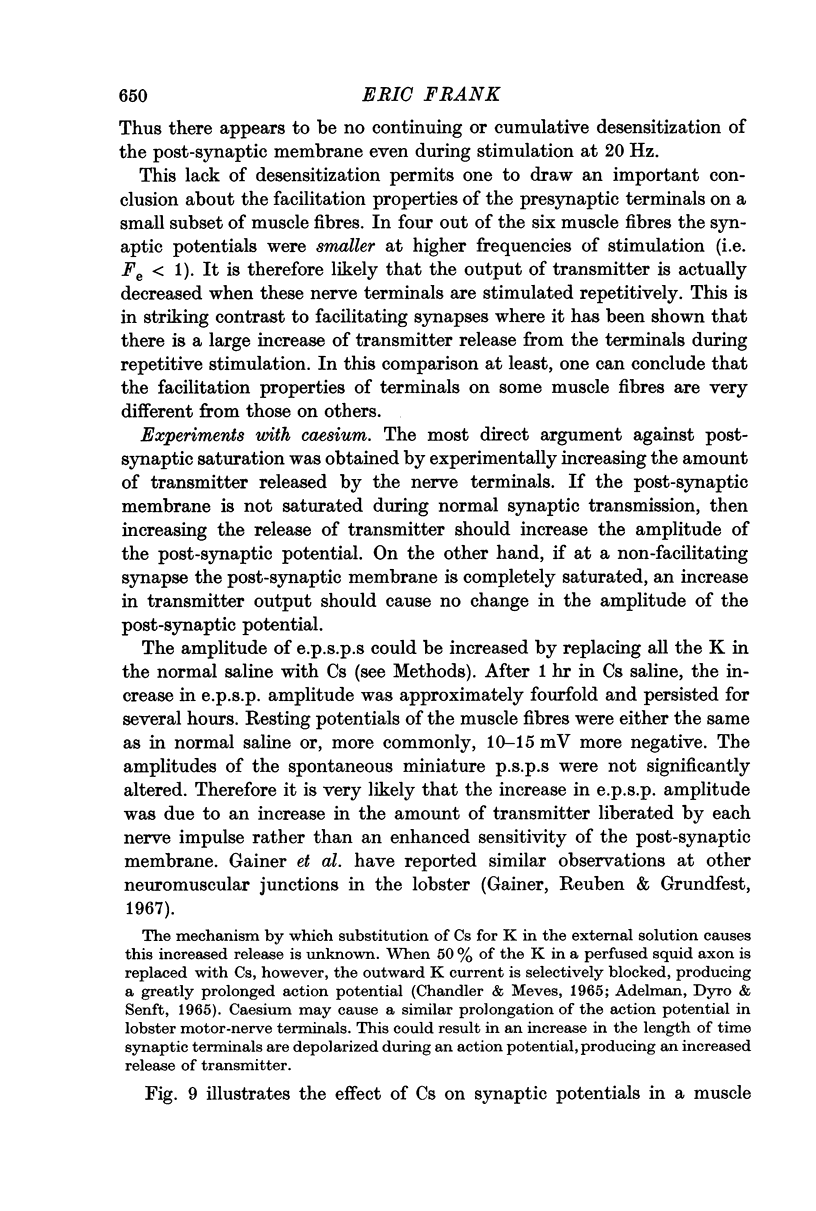Abstract
1. The facilitation of neuromuscular transmission, which occurs during repetitive activation, was examined in the proximal accessory flexor muscle in walking legs of the lobster using electrophysiological techniques.
2. Post-synaptic potentials (p.s.p.s) in different muscle fibres facilitated to markedly different degrees. P.s.p.s in some fibres did not facilitate at all, while in others they increased in size by 20-30 times during stimulation at 20 Hz even though all the excitatory neuromuscular synapses are made by a single axon.
3. Stimulation of widely separated groups of synapses on any single muscle fibre evoked p.s.p.s with closely matched facilitation properties. Extracellular p.s.p.s recorded from single synaptic spots showed the same characteristics of facilitation as those of intracellular p.s.p.s in the same muscle fibre, suggesting that individual synaptic contacts on any single fibre are similar to each other.
4. Facilitation can be accounted for by an increase in the number of quanta released from the nerve terminals. There is no evidence for an increase in post-synaptic membrane sensitivity.
5. Low Ca solutions reduce transmitter release with comparatively little change in facilitation, while Cs solutions increase the size of p.s.p.s without increasing the amplitude of spontaneous miniature potentials. Thus, at poorly facilitating synapses it is unlikely that the absence of facilitation is caused by the saturation of some post-synaptic process.
6. It is concluded that the excitatory presynaptic nerve terminals on a single muscle fibre have matching facilitation characteristics. Some interaction between individual muscle fibres and their associated nerve endings may be required to establish or maintain this matching.
Full text
PDF























Selected References
These references are in PubMed. This may not be the complete list of references from this article.
- Atwood H. L., Bittner G. D. Matching of excitatory and inhibitory inputs to crustacean muscle fibers. J Neurophysiol. 1971 Jan;34(1):157–170. doi: 10.1152/jn.1971.34.1.157. [DOI] [PubMed] [Google Scholar]
- Atwood H. L. Variation in physiological properties of crustacean motor synapses. Nature. 1967 Jul 1;215(5096):57–58. doi: 10.1038/215057a0. [DOI] [PubMed] [Google Scholar]
- Bittner G. D. Differentiation of nerve terminals in the crayfish opener muscle and its functional significance. J Gen Physiol. 1968 Jun;51(6):731–758. doi: 10.1085/jgp.51.6.731. [DOI] [PMC free article] [PubMed] [Google Scholar]
- Bittner G. D., Harrison J. A reconsideration of the Poisson hypothesis for transmitter release at the crayfish neuromuscular junction. J Physiol. 1970 Jan;206(1):1–23. doi: 10.1113/jphysiol.1970.sp008994. [DOI] [PMC free article] [PubMed] [Google Scholar]
- Chandler W. K., Meves H. Voltage clamp experiments on internally perfused giant axons. J Physiol. 1965 Oct;180(4):788–820. doi: 10.1113/jphysiol.1965.sp007732. [DOI] [PMC free article] [PubMed] [Google Scholar]
- DEL CASTILLO J., KATZ B. Localization of active spots within the neuromuscular junction of the frog. J Physiol. 1956 Jun 28;132(3):630–649. doi: 10.1113/jphysiol.1956.sp005554. [DOI] [PMC free article] [PubMed] [Google Scholar]
- DEL CASTILLO J., KATZ B. Statistical factors involved in neuromuscular facilitation and depression. J Physiol. 1954 Jun 28;124(3):574–585. doi: 10.1113/jphysiol.1954.sp005130. [DOI] [PMC free article] [PubMed] [Google Scholar]
- DUDEL J., KUFFLER S. W. Mechanism of facilitation at the crayfish neuromuscular junction. J Physiol. 1961 Mar;155:530–542. doi: 10.1113/jphysiol.1961.sp006645. [DOI] [PMC free article] [PubMed] [Google Scholar]
- DUDEL J., KUFFLER S. W. The quantal nature of transmission and spontaneous miniature potentials at the crayfish neuromuscular junction. J Physiol. 1961 Mar;155:514–529. doi: 10.1113/jphysiol.1961.sp006644. [DOI] [PMC free article] [PubMed] [Google Scholar]
- Johnson E. W., Wernig A. The binomial nature of transmitter release at the crayfish neuromuscular junction. J Physiol. 1971 Nov;218(3):757–767. doi: 10.1113/jphysiol.1971.sp009642. [DOI] [PMC free article] [PubMed] [Google Scholar]
- Katz B., Miledi R. The timing of calcium action during neuromuscular transmission. J Physiol. 1967 Apr;189(3):535–544. doi: 10.1113/jphysiol.1967.sp008183. [DOI] [PMC free article] [PubMed] [Google Scholar]
- Mallart A., Martin A. R. The relation between quantum content and facilitation at the neuromuscular junction of the frog. J Physiol. 1968 Jun;196(3):593–604. doi: 10.1113/jphysiol.1968.sp008525. [DOI] [PMC free article] [PubMed] [Google Scholar]
- Sherman R. G., Atwood H. L. Correlated electrophysiological and ultrastructural studies of a crustacean motor unit. J Gen Physiol. 1972 May;59(5):586–615. doi: 10.1085/jgp.59.5.586. [DOI] [PMC free article] [PubMed] [Google Scholar]
- Wernig A. Changes in statistical parameters during facilitation at the crayfish neuromuscular junction. J Physiol. 1972 Nov;226(3):751–759. doi: 10.1113/jphysiol.1972.sp010007. [DOI] [PMC free article] [PubMed] [Google Scholar]
- Wernig A. The effects of calcium and magnesium on statistical release parameters at the crayfish neuromuscular junction. J Physiol. 1972 Nov;226(3):761–768. doi: 10.1113/jphysiol.1972.sp010008. [DOI] [PMC free article] [PubMed] [Google Scholar]


